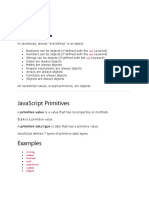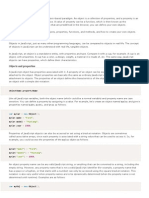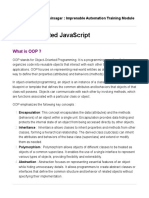A Comprehensive Guide to JavaScript Objects - Part 1
Uploaded by
xubairaccaA Comprehensive Guide to JavaScript Objects - Part 1
Uploaded by
xubairacca11/19/24, 4:39 AM A Comprehensive Guide to JavaScript Objects - Part 1
A Comprehensive Guide to JavaScript Objects -
Part 1
JavaScript objects are one of the core building blocks of the language. They are versatile and allow for dynamic, structured
data manipulation. This chapter covers the fundamentals of objects, including their declaration, mutation, properties,
methods, and advanced use cases.
What Are Objects in JavaScript?
An object in JavaScript is a standalone entity that holds properties and methods. Properties are key-value pairs, and methods
are functions stored as values of object properties. Objects are used extensively in JavaScript for storing and manipulating
structured data.
Example
let car = {
make: 'Toyota',
model: 'Corolla',
year: 2020,
drive: function() {
console.log('The car is driving.');
}
};
Declaring Objects
There are multiple ways to declare objects in JavaScript. The most common methods include:
Using Object Literals
This is the simplest and most common way to create objects.
let person = {
firstName: 'John',
lastName: 'Doe',
age: 30
};
Using the new Object() Constructor
The constructor approach can be useful in certain scenarios, but it is less commonly used.
let book = new Object();
book.title = 'JavaScript Basics';
book.author = 'Jane Doe';
file:///home/zub/Desktop/A Comprehensive Guide to JavaScript Objects - Part 1.html 1/4
11/19/24, 4:39 AM A Comprehensive Guide to JavaScript Objects - Part 1
book.pages = 200;
Using Object.create()
Objects can also be created using a prototype object.
let proto = {greet: function() { console.log('Hello!'); }};
let obj = Object.create(proto);
obj.name = 'Alice';
console.log(obj.name); // Output: Alice
obj.greet(); // Output: Hello!
Accessing Object Properties
Properties in JavaScript objects can be accessed in two ways:
Dot Notation
console.log(person.firstName); // Output: John
person.age = 31; // Modify age property
Bracket Notation
Useful when property names include spaces or special characters, or when they are dynamic.
let propName = 'lastName';
console.log(person[propName]); // Output: Doe
person['age'] = 32; // Modify using bracket notation
Mutating Objects
Objects in JavaScript are mutable. You can add, modify, or delete properties dynamically.
Adding New Properties
person.gender = 'Male';
console.log(person.gender); // Output: Male
Deleting Properties
delete person.age;
console.log(person.age); // Output: undefined
file:///home/zub/Desktop/A Comprehensive Guide to JavaScript Objects - Part 1.html 2/4
11/19/24, 4:39 AM A Comprehensive Guide to JavaScript Objects - Part 1
Object Methods
JavaScript provides a variety of built-in methods to work with objects.
Object.keys()
Returns an array of the object’s keys.
console.log(Object.keys(person)); // Output: ['firstName', 'lastName', 'gender']
Object.values()
Returns an array of the object’s values.
console.log(Object.values(person)); // Output: ['John', 'Doe', 'Male']
Object.entries()
Returns an array of key-value pairs.
console.log(Object.entries(person));
// Output: [['firstName', 'John'], ['lastName', 'Doe'], ['gender', 'Male']]
Object.assign()
Copies properties from one object to another.
let target = {};
Object.assign(target, person);
console.log(target);
// Output: {firstName: 'John', lastName: 'Doe', gender: 'Male'}
Looping Through Objects
Since objects are not inherently iterable, you need to use specific methods or loops to iterate over them.
Using for...in
for (let key in person) {
console.log(key + ': ' + person[key]);
}
// Output:
// firstName: John
// lastName: Doe
// gender: Male
file:///home/zub/Desktop/A Comprehensive Guide to JavaScript Objects - Part 1.html 3/4
11/19/24, 4:39 AM A Comprehensive Guide to JavaScript Objects - Part 1
Using Object.entries() with for...of
for (let [key, value] of Object.entries(person)) {
console.log(key + ': ' + value);
}
// Output:
// firstName: John
// lastName: Doe
// gender: Male
Nested Objects
Objects can contain other objects, enabling you to model complex data structures.
Example
let company = {
name: 'Tech Corp',
location: {
city: 'San Francisco',
country: 'USA'
},
employees: 500
};
console.log(company.location.city); // Output: San Francisco
Accessing Nested Properties
Use dot or bracket notation to access nested properties.
company.location.state = 'California'; // Add a new nested property
console.log(company.location);
// Output: {city: 'San Francisco', country: 'USA', state: 'California'}
file:///home/zub/Desktop/A Comprehensive Guide to JavaScript Objects - Part 1.html 4/4
You might also like
- A Comprehensive Guide to JavaScript Objects - Part 2No ratings yetA Comprehensive Guide to JavaScript Objects - Part 24 pages
- 3JS-Part3 Objects, Properties, And Methods of the DOMNo ratings yet3JS-Part3 Objects, Properties, And Methods of the DOM85 pages
- Javascript is the programming language of the webNo ratings yetJavascript is the programming language of the web16 pages
- Objects: Objects: The Basics Page 1 of 47No ratings yetObjects: Objects: The Basics Page 1 of 4747 pages
- Chapter 3: Client-Side Scripting LanguageNo ratings yetChapter 3: Client-Side Scripting Language21 pages
- JavaScript - Arrays, Loops, and Objects - Objects Cheatsheet - CodecademyNo ratings yetJavaScript - Arrays, Loops, and Objects - Objects Cheatsheet - Codecademy7 pages
- Learn JavaScript - Objects Cheatsheet - CodecademyNo ratings yetLearn JavaScript - Objects Cheatsheet - Codecademy10 pages
- 9.Learn JavaScript_ Objects Cheatsheet _ CodecademyNo ratings yet9.Learn JavaScript_ Objects Cheatsheet _ Codecademy10 pages
- Learn JavaScript - Objects Cheatsheet - CodecademyNo ratings yetLearn JavaScript - Objects Cheatsheet - Codecademy10 pages
- Learn JavaScript - Objects Cheatsheet - CodecademyNo ratings yetLearn JavaScript - Objects Cheatsheet - Codecademy7 pages
- Introduction To JavaScript Functions Arrays and ObjectsNo ratings yetIntroduction To JavaScript Functions Arrays and Objects8 pages
- Learn JavaScript - Objects Cheatsheet - CodecademyNo ratings yetLearn JavaScript - Objects Cheatsheet - Codecademy9 pages
- Creating and Using Javascript Objects: Presented by Developerworks, Your Source For Great TutorialsNo ratings yetCreating and Using Javascript Objects: Presented by Developerworks, Your Source For Great Tutorials32 pages
- Web Design and Development Lecture 9 B - JavaScript AdvancedNo ratings yetWeb Design and Development Lecture 9 B - JavaScript Advanced34 pages
- Begontes, Messy PORTFOLIO Batch 2023 Episode 8-15No ratings yetBegontes, Messy PORTFOLIO Batch 2023 Episode 8-1553 pages
- Fixed Asset BO Universe For Oracle EBS (12.1.x) : by Ishaq BaigNo ratings yetFixed Asset BO Universe For Oracle EBS (12.1.x) : by Ishaq Baig18 pages
- 2013 Basic Electrical Engineering: CS/B.Tech (OLD) /SEM-2/EE-201/2013No ratings yet2013 Basic Electrical Engineering: CS/B.Tech (OLD) /SEM-2/EE-201/20138 pages
- ENELTEC-QT-LED Explosion Proof Linear LightsNo ratings yetENELTEC-QT-LED Explosion Proof Linear Lights1 page
- Assessment of Design Procedures For Vertical Borehole Heat ExchangersNo ratings yetAssessment of Design Procedures For Vertical Borehole Heat Exchangers11 pages
- 5 - Ce 112 - Background of The ProfessionNo ratings yet5 - Ce 112 - Background of The Profession17 pages
- The New Governance: Governing Without GovernmentNo ratings yetThe New Governance: Governing Without Government16 pages
- IRCTC Next Generation Eticketing System 2No ratings yetIRCTC Next Generation Eticketing System 21 page
- PART 2 Organizational Unit User and Folder Redirection (1)No ratings yetPART 2 Organizational Unit User and Folder Redirection (1)5 pages
- (Original PDF) Canadian Social Policy A New Introduction 5th Canadian Edition 2024 Scribd DownloadNo ratings yet(Original PDF) Canadian Social Policy A New Introduction 5th Canadian Edition 2024 Scribd Download45 pages
- CELPIP Listening Tips To Get A Higher Score 2022No ratings yetCELPIP Listening Tips To Get A Higher Score 20222 pages
- Clinical Chemistry Line: Almost 50 Years of Experience Make The DifferenceNo ratings yetClinical Chemistry Line: Almost 50 Years of Experience Make The Difference16 pages
- Econometrics Multiple Regression Analysis: HeteroskedasticityNo ratings yetEconometrics Multiple Regression Analysis: Heteroskedasticity19 pages
























































































